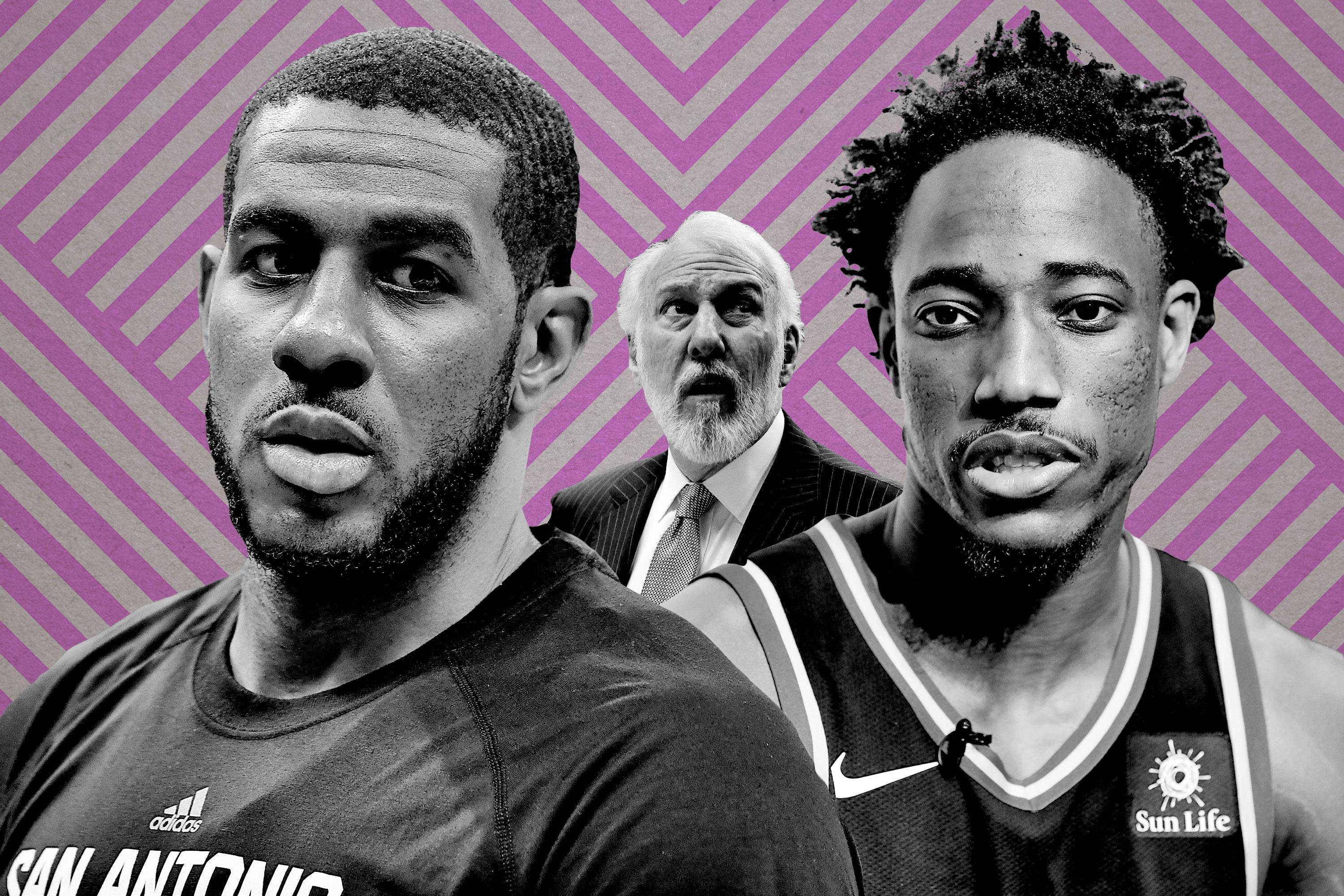
Kawhi Leonard’s most recent game was played six months ago, and it’s getting harder and harder to tell whether or not that feels like yesterday or an eternity ago. The flurry of daily rumors has outpaced the speed of the game itself, which is already operating at its fastest rate in decades. Even as Leonard geared up for his return from a quad injury last December, his stardom within the Spurs machine seemed aberrational; he was a talent capable of breaking all the patterns that San Antonio had established during the past two decades, and could lead San Antonio into a completely different future. But through the bizarre, often frustrating slow burn of Leonard’s disintegration from the Spurs organization, who could have predicted the end result?
After months of crisis management, bizarre reports coming from the recesses of Kawhi’s mysterious inner circle, and two weeks after the tidal wave of LeBron’s westward expansion, San Antonio finally made a decision: On Wednesday morning, the Spurs traded Leonard and Danny Green—the NBA’s best defensive duo on the perimeter as recently as 2017—to the Raptors for DeMar DeRozan, Jakob Poeltl, and a protected 2019 first-round pick.
Let’s get going on the Sports Illustrated cover photo shoot now—DeRozan on the left and LaMarcus Aldridge on the right with their heads tilted and scrunched faces: Now This Is Going to Be Weird. The only remaining Spurs players from their 2014 title run are Patty Mills, recent free-agent signee Marco Belinelli, and Manu Ginobili, who has yet to announce whether or not he plans to return for his 17th season. After a seamless transition from David Robinson to Tim Duncan to Leonard, the Spurs will not have a generational talent at the helm of on-court operations for the first time in three decades. The Spurs will be unrecognizable with Aldridge and DeRozan leading the way, but, in a fitting bit of irony, they’ll align more closely with their perception as dull and methodical than they have at any point since the turn of the century. They have no other choice but to lean into it.
The Spurs are now a team of loose approximations, with two stars who are living wax statues of the archetypal wing and power forward of the early 2000s. Aldridge was signed in the summer of 2015 as Duncan’s heir apparent, and after a terrific bounce-back season following the three-year, $72.3 million extension he signed last October, it’s clear that Gregg Popovich is comfortable coaching him within the templates he’s constructed. That leaves DeRozan in the unenviable position of filling a void left by the best two-way player in the NBA. Both Aldridge and DeRozan are very good, All-NBA-caliber players, but neither has the type of game (nor résumé) that inspires much confidence for a team with championship aspirations. Still, the reboot will be intriguing for anyone who has ever wondered what Popovich could do with a star import. If you squint hard enough, you might see the faint outlines of Kawhi in DeRozan—on the offensive end, at least. Both wings are extremely reliable in the pick-and-roll, and have an innate understanding of how to leverage their talents in isolation. Problem is, if you’re a Spurs fan investing in their similarities, you’re going to be spending much of your waking hours squinting for the next two years.
DeRozan can approximate Kawhi at his most soloistic, but he only scratches the surface of what Kawhi can do on offense. Leonard’s MVP-caliber season in 2016-17 was a marvel: His scoring efficiency in seven of the nine major offensive play types ranked at least in the 72nd percentile of all NBA players (and he is in the 80s and 90s in a majority of them). DeRozan in 2017-18 was in at least the 72nd percentile in only three (transition, isolation, pick-and-roll ball handler). Still, Pop should be able to work within the confines of DeRozan’s specific set of skills, and expand on the progress the hardworking wing made last season. For whatever relapse DeRozan was going through at the tail end of the Raptors’ pathetic playoff run a few months ago, he was solid from 3-point range in catch-and-shoot situations, hitting just under league average on two attempts per game. He’ll be given as many reps in those situations as he can handle, especially with Green, San Antonio’s longtime release valve, also heading to Toronto.
Defense is generally a nurture-over-nature proposition, and the Spurs have to hope DeRozan isn’t an exception. Earlier this month, new Raptors head coach Nick Nurse talked about setting heightened defensive expectations for his former star: “Maybe instead of hiding him in a regular-season game on a poor offensive player in December, maybe we’re gonna throw him on an All-Star,” he said in a SiriusXM interview. “Maybe it costs us a little bit, but maybe he learns a thing or two that will help him down the line.” DeRozan won’t have a choice but to do so in San Antonio, playing in a merciless Western Conference on a team that just traded away its two best perimeter defenders.
The Spurs have had a top-five defense every season since 2012-13, but have always been buoyed by savants like Duncan and Green, who always had a sense of where they should be on that end. Dejounte Murray, the incumbent starter at point guard, has the instincts (and the length and explosiveness) to be that kind of guy, but it’d be a tough ask for a player whose listed weight is 170 pounds to cover for his backcourt mates across three positions. In that sense, San Antonio’s inability to wrest OG Anunoby from the Raptors’ clutches is a slight disappointment (and a huge win for Toronto). Should Pop be able to turn this team—without a true multipositional stopper at any position, and without reliable rim protection—into a top-five defense, it might just be one of his finest non-championship accomplishments.
The Spurs will also get to see what they have in Poeltl, the no. 9 pick in the 2016 draft, who was efficient playing alongside the best second unit in basketball last season. There is one key figure that stands out when observing Poeltl’s statistical profile: According to Second Spectrum’s player-tracking data, Poeltl allowed opponents to score on him at the rim only 53.6 percent of time, which puts him third (behind Joel Embiid and Derrick Favors) among all players who have defended at least 350 shots from point-blank range.
Of the 16 players who qualified, Poeltl was the only player who wasn’t a starter for his respective team. Of course, this means he racked up most of his numbers against reserves, so while his block rate and rim protection numbers are outstanding, it’s hard to suggest him as an elite rim protector, or even one who might be ready to slide in as a potential starter alongside Aldridge up front. There’s a reason he was often unplayable during the Raptors’ postseason run; he’s nowhere near as effective in space, and lacks any offensive polish to contribute on the other end of the floor. That said, he projects to be a prototypical Spurs defensive center, considering how well the team applies help defense.
This upcoming Spurs season will be completely unpredictable. Continuity had long been the defining characteristic of the organization and long been a point of pride in its fan base; now more than ever, Pop is the only Spur to truly believe in. Popovich praised Leonard for his time in San Antonio in front of reporters on Wednesday, but kept it short; there are newer challenges on his horizon, the likes of which he’s seldom seen as part of the Spurs. “I’m concerned about Jakob and DeMar and our basketball team and putting that together,” Popovich said. “We got a lot of young kids, and it’s exciting. But in no way, shape, or form, does it do any good to go back in time and talk about A, B, or C. It’s time to move on.”
Last November, during the first deluge of questions regarding Kawhi’s return, Popovich told the media that he’d essentially prepped the Spurs for the apocalypse, recalibrating his team under the assumption that he would never return. “A team just has to play in a sense like he doesn’t exist,” Popovich said then. “Nobody cares if you lost a good player, right?” That team won 47 games last season, and a team that adds DeRozan to its roster is going to improve its regular-season win total; he may not have the postseason chops to lead a team past elite competition in a seven-game series, but he’s wildly effective against the rest of the league. Yet, for the first time in a long time, next season’s results seem beside the point for the Spurs.
San Antonio, for as long as Popovich has been on the bench, has been a team on the brink of a title or the subject of premature burials. Now, without Leonard, whose star turn in 2014 changed San Antonio’s entire trajectory, our collective Spurs death pool has reemerged in earnest. There aren’t any delusions about DeRozan becoming the team’s star of the future. The Spurs will start this strange new era in a holding pattern, as the team will learn in real time whether there is still any magic in their scouting: all of the young talent they’re banking on, from Murray to Lonnie Walker IV to Derrick White, were drafted in the mid-to-late first round. In the meantime, the roster reflects the Spurs’ awkward new reality: one that’s decidedly uncommitted to its future, and quickly unbinding from its past.

